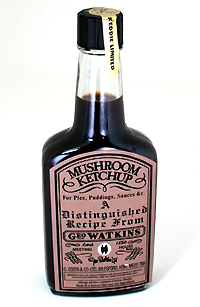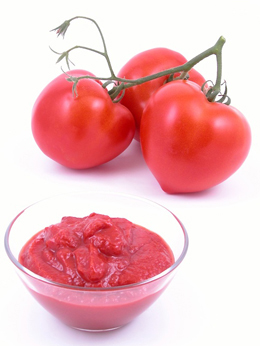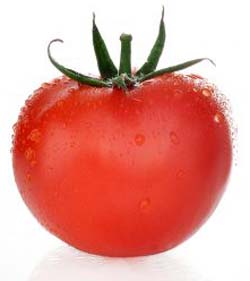

Some ketchups are mixed with diced onions and bell peppers. You can add your own, of course, as well as crumbled bacon, shown in the photo above. Photo courtesy Mir Glen.
|
STEPHANIE ZONIS is a Contributing Editor at THE NIBBLE.
|
|
October 2007
Last Updated August 2010
|
 |
A Fresh Look At Ketchup
Page 2: The History Of Ketchup
This is Page 2 of a nine-page article. Click on the black links below to visit other pages.
The History Of Ketchup: Preserve Us!
Having at least one good method of preserving food has been vital to civilizations for millennia. Lacking modern methods of processing and refrigeration, earlier societies often turned to salting, brining (soaking foods in a mixture of salt and water) and/or pickling (immersing foods in a diluted vinegar solution). Sometimes, salting and pickling were used in combination. The idea here was to prevent harmful bacteria from entering into, and growing on, the food.
 Sauces have been used on foods since ancient times. Early sauces in Greek and Rome were often made from salting or fermenting fish, while those in Asia were made from fish or soybeans. They survive today in the form of the Thai fish sauce name plat (the same type of sauce goes by a different name in each Asian country); and the Romans’ favorite condiment, garum, an expensive fish sauce used by the wealthy the way we use table salt, survives as a costly specialty food called colatura (in photo—you can purchase it Amazon.com). Sauces have been used on foods since ancient times. Early sauces in Greek and Rome were often made from salting or fermenting fish, while those in Asia were made from fish or soybeans. They survive today in the form of the Thai fish sauce name plat (the same type of sauce goes by a different name in each Asian country); and the Romans’ favorite condiment, garum, an expensive fish sauce used by the wealthy the way we use table salt, survives as a costly specialty food called colatura (in photo—you can purchase it Amazon.com).
Ketchup In Europe
In the medieval era, sauces often had an acidic base, such as vinegar, ale or wine. But in the late 1600s and early 1700s, sauces became less fashionable; they were replaced by pickled vegetables, especially mushrooms and walnuts. These pickles, in addition to vinegar, contained spices. The liquid from a mushroom pickle, with a deep brown hue from the vegetable and flavored by spices, came to be seen as a condiment by itself.
Andrew Smith writes that the British initially ran into ketchup in Southeast Asia, during the years when Britannia was first attempting to rule the waves. What they found, however, was not one product, but several. There were a handful of different sauces made from fermented soy beans or fish, with varying textures, thicknesses and levels of saltiness (and even sweetness). Smith states that ketchups were being imported into England prior to 1680.
The First Known Recipe For Ketchup
|
|

Watkins Mushroom Ketchup, a rich cooking sauce, was the “secret of success” of many Victorian cooks in England. Made with dried mushrooms, roasted barley malt extract and spices, it is still used today, as we use tomato ketchup, to enhance steak and roast meats. Similar in consistency to Worcestershire sauce, a dash added while cooking also enhances soups and stews. Try it for yourself at iGourmet.com. It was one of our favorites in the non-tomato ketchup category. |
The first known recipe for ketchup in English was published in 1727 by a female author surnamed Smith. Part of a volume entitled Compleat Housewife; or, Accomplished Gentlewoman’s Companion, the condiment was spelled as “kachop.” Ingredients included anchovies, shallots, white wine vinegar, two types of white wine, mace, ginger, cloves, whole peppers, a whole nutmeg, lemon peel and horseradish—a kind of early Worcestershire sauce.
By the mid-1700s ketchups were a staple in British shops. There were three basic types: mushroom, walnut and fish. Naturally, British recipes and food preferences were predominant among colonists in the soon-to-be United States. If tomato ketchup was being made during this era, it does not seem to have been sold commercially. Although U.K. citizens were eating tomatoes by this time, there were still many in the fledgling U.S. (as well as in Europe) who believed that tomatoes (also called love apples and wolf peaches), as members of the nightshade family, were poisonous.
The Origin Of Tomato Sauce &
Tomato Ketchup
In fact, only famine in Italy caused the peasants to eat tomatoes. Although yellow cherry tomatoes had been brought back from the New World by Christopher Columbus at the turn of the 16th century and then by Hernando Cortez in 1529, only lean times drove people to eat the fruit. No one died, and the first documented tomato sauce recipe in Italy is from 1839.
The first known recipe for tomato ketchup was published in 1804 by James Mease, a Philadelphia physician and scientist. The next 25 years saw a great rise in the condiment’s popularity, although tomato ketchup shared the spotlight with the three traditional British mainstay varieties, as well as ketchups made from a host of other foods (including oysters, lemons, cucumbers, and elderberries).
|
|

It’s hard to believe, but tomato ketchup
didn’t appear until 1804. It was homemade—commercial ketchup debuted in the late 1800s. Photo © Monika Adamczyk | Fotolia. |
Cookbook upon cookbook printed recipes for homemade ketchups. As Smith notes, good keeping quality was an important reason for ketchup’s popularity. And because most ketchups were concentrated products, only a small quantity was required to add a lot of flavor.
Early tomato ketchups were not sweetened per se (they contained some sweet spices, but not sugar or other sweeteners). When sugar started to be added to ketchup (in the mid-1800s), only a small quantity was used at first. This resulted in fermentation, which meant sour-tasting ketchup. When more sugar was added to sweeten the sour taste, a greater quantity of vinegar was added to keep the sweetness in check. The larger amount of vinegar resulted in a chemical reaction that created “invert” sugars (a process whereby sucrose, or table sugar, is broken down into its component simple sugars, glucose and fructose), which made the ketchup sweeter still.
Homemade ketchup remained a well-loved staple until commercial ketchup began to take over in the late 1800s. Ketchup-making at home was time-consuming, tedious and involved many steps, while mass production capability and improved techniques made commercial ketchups less and less expensive.
Ketchup As We Know It
In the late 1800s and early into the twentieth century, commercially-made tomato ketchup was confronted with many of the same issues then affecting other foods produced by professional manufacturers, some of whom were rather less professional than could be desired. Boric acid, benzoic acid and sodium benzoate, once widely used as preservatives in ketchup, were increasingly believed to produce adverse health effects. Ketchups were made from rotted, decomposed or unripe tomatoes; some contained artificial coloring, which was often based on coal-tar. They contained starches or other unsuitable ingredients, such as pumpkin. The passage of the Pure Food and Drugs Act, in 1906, was a big first step in forcing tomato ketchup manufacturers to clean up their act. But how could they guarantee the keeping and eating qualities of ketchup without preservatives?
Heinz Becomes A Ketchup Hero
The H.J. Heinz Company set out to prove that this was not an impossible task. According to Andrew Smith, Heinz began the ketchup-making process with red, ripe tomatoes, not the green, underripe fruit or the overripe fruit so often used in that era. Ripe tomatoes contain more pectin, a gelling agent, and pectin content was crucial in creating a higher-density product that had more body.
| Heinz’s ketchup had far more solids, in it, too. It “contained more salt and almost twice as much sugar and vinegar” as other ketchups manufactured commercially. And, thanks to the keeping qualities of higher amounts of vinegar, sugar and salt, Heinz ketchup did not require preservatives. The company guaranteed its product against spoilage, in fact. Because of effective advertising campaigns and lobbying by Heinz and other manufacturers, and more studies showing the downsides of using benzoate and benzoate-related products, virtually all ketchups on the market were preservative-free by 1911. |
|

Photo of tomato by A. Kotz | SXC. |
Today’s ketchup industry differs greatly from what it once was. Many of the small manufacturers that produced tomato ketchup in the twentieth century are gone, bought out or forced out of business by poor sales (although a number have sprung up in more recent years). Tomato varieties specifically geared toward ketchup production have been developed. More tomatoes are now grown in China than anywhere else in the world. Changes in transportation and manufacturing processes have been enormous. There have been alterations in the basic Heinz formula, too, but not that many. Most notably, those changes have been in the sweetener used. Instead of sugar, almost all mass-produced ketchup now uses corn syrup, high fructose corn syrup or a combination of the two.
More Modern Ketchup
Perhaps the silliest moment in ketchup’s history came in 1981, at a time when the Reagan administration attempted to declare ketchup (and pickle relish) as a vegetable. Doing so would allow the government to save money on the federally-funded school lunch programs.
President Reagan attempted to defend this classification by noting that ketchup is made from tomatoes. Among howls of protest from parents, nutritionists and almost everyone else except schoolchildren, however, the undertaking was hastily shelved…until 1995, when a GOP-controlled Congress gave it another try, for the same reason.
The last laugh of this incident may be on the American public. In the Food and Drug Administration’s standards (Title 21), revised in April of 2006, ketchup is indeed listed under the “Canned Vegetables” subheading.
|
|

The administration of President Ronald Reagan tried to have ketchup declared a vegetable. Photo of tomato by A. Kotz | SXC. |
The 1981 declaration had serious consequences for one of the “Big Three” ketchup manufacturers at that time. Heinz and Hunt’s spelled their condiment “ketchup,” so they were fine. But Del Monte had been using the “catsup” spelling. With the government’s decision that “ketchup” was a vegetable, Del Monte was out in the cold. Given the speed with which the ketchup declaration was revoked, this amounted to no big deal. Soon afterward, however, Del Monte changed the spelling of their product to “ketchup,” and it’s been that way ever since.
Release of the proposed directive for required public comment in September 1981 met with outrage from nutritionists and Democrats.[1]
Continue To Page 3: How Ketchup Is Manufactured
Go To The Article Index Above

|





 Sauces have been used on foods since ancient times. Early sauces in Greek and Rome were often made from salting or fermenting fish, while those in Asia were made from fish or soybeans. They survive today in the form of the Thai fish sauce name plat (the same type of sauce goes by a different name in each Asian country); and the Romans’ favorite condiment, garum, an expensive fish sauce used by the wealthy the way we use table salt, survives as a costly specialty food called
Sauces have been used on foods since ancient times. Early sauces in Greek and Rome were often made from salting or fermenting fish, while those in Asia were made from fish or soybeans. They survive today in the form of the Thai fish sauce name plat (the same type of sauce goes by a different name in each Asian country); and the Romans’ favorite condiment, garum, an expensive fish sauce used by the wealthy the way we use table salt, survives as a costly specialty food called 


